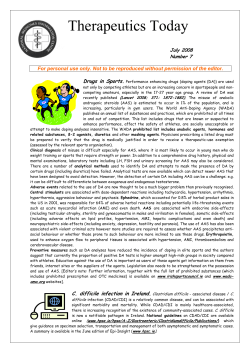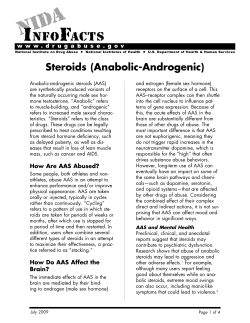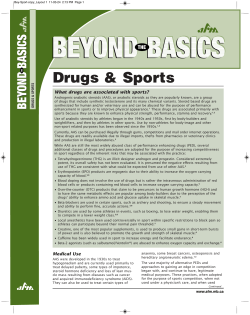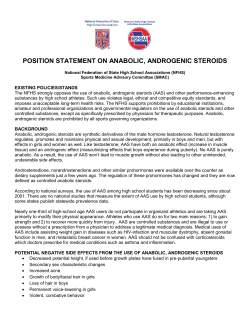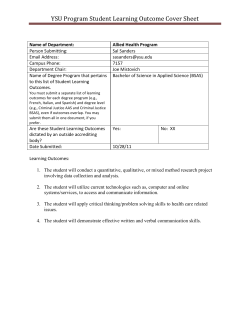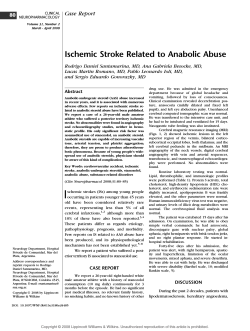
A body-builder and his surreptitious steroid use Learning Objectives Initial Studies Differential Diagnosis
A body-builder and his surreptitious steroid use Sonica Bhatia, M.D.; Anne Kastor, M.D. Department of Medicine, New York Presbyterian Hospital/Weill Cornell Medical College; New York, NY Learning Objectives 1. To recognize signs and symptoms of anabolic-androgenic steroid (AAS) use. 2. To recognize AAS dependence, and barriers to AAS cessation in the primary care setting. Presentation Initial Studies Hemoglobin : 17.6 g/dL (Borderline high) LDL: 262 mg/dL (High) HDL: 19 mg/dL (Low) Basic metabolic panel & TSH: normal EKG: Normal sinus rhythm, with borderline left ventricular hypertrophy 3 months later Chief Complaint: Palpitations, flushing, chest discomfort, loose bowel movements, and shortness of breath over the last month. HPI: 31 year-old male presents at a primary care doctor’s office for follow-up of multiple episodes of the above symptoms over the last month. - associates symptoms with eating a variety of foods and taking a caffeine pill prior to exercising. - notes increased anxiety when going to the gym, but does not feel chest discomfort or shortness of breath while exercising. - denies sexual dysfunction. - Reports that he last took human growth hormone about 3 months prior to this visit. Past Medical & Surgical History: asthma, obstructive sleep apnea Allergies: NKDA Family History: Father with myocardial infarction at age 50 Social History: Works as concierge at a gym. Former body-builder. No tobacco, alcohol, or cocaine. Physical Exam: 134/90 69 BMI 30 Young man with very muscular build Mild b/l gynecomastia Normal cardiac and pulmonary exam Normal testicular size References available upon request. Differential Diagnosis Differential diagnosis of constellation of presenting symptoms: • carcinoid • hyperthyroidism • pheochromocytoma • myocardial infarction • panic disorder • cocaine abuse • adverse effect of supplement Discussion Subsequent Studies 5-HIAA urine: normal TTE: borderline low ejection fraction 24-hour EKG monitoring: no arrhythmia LH: <0.2mIU/mL (Low) FSH: <0.2mIU/mL (Low) 8 months later Additional History Obtained - methenolone acetate (primabolan) for 16 years - human growth hormone in past year - clomiphene in past year - tapering testosterone from daily to weekly injections. Started on SSRI Outcome 4 months after initiation of SSRI: - Improvement in symptoms - Improvement in lipid panel - Improvement in blood pressure AAS use became more prevalent among non-elite athletes beginning in the 1980s. Adverse effects linked to AAS use include: • AAS-induced cardiomyopathy • hypertension • dyslipidemia • polycythemia • atherosclerotic disease • sexual dysfunction • symptoms of mood disorders Underground steroid guides advise AAS users to inject in “cycles” and to use clomiphene, both of which allow the HPG axis to recover. AAS withdrawal may induce major depression and uncover bodyimage disorders: • Loss of muscularity can induce anxiety. • SSRIs and cognitive behavioral therapy can help patients with signs of AAS dependence. This case demonstrates some of the signs and symptoms of AAS use, and that mood disorders and body-image disorders may be revealed in the setting of discontinuation of AAS, making AAS cessation challenging for patients and providers.
© Copyright 2025




